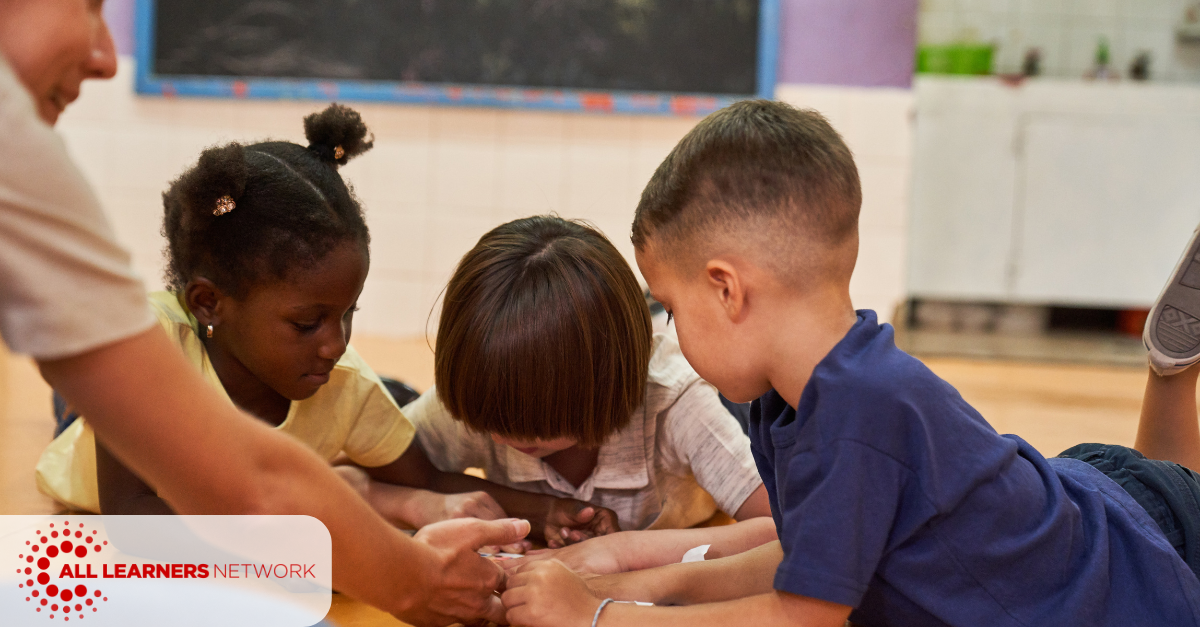
Valuing Play as a Partner in Teaching and Learning
Published: April 4, 2025
“Play is not a luxury. It is a necessity."
Kay Redfield Jamison, PhD
In her book, The Importance of Being Little-What Young Children Really Need from Grownups (2016), Erika Christakis writes that, “play is the fundamental building block of human cognition, emotional health, and social behavior”. Through play, learners are developing a wide array of skills, habit, and behaviors–e.g. language, speaking and listening skills, numeracy, fine and gross motor growth, and discovering or inventing problem solving strategies. When children are at play, they are often relaxed and curious. Their curiosity and creativity drives how they plan for play. As they take in their surroundings, they make decisions about what tools they will use and what roles they will take on. If they need an item that is not available, they will often build what they need or designate another object to stand in for the needed item. In their busy planning and playing, they are making choices, having discussions with their peers, experiencing and navigating frustrations, and learning to solve problems independently.
The importance and value of play has been researched and written about extensively, and yet some early childhood educators find themselves having to balance time for play with time for learning. The goal of this blog is to advocate for the idea that playing is learning and to illuminate how the All Learners Network Pre-K and Kindergarten High Leverage Concepts (HLCs) are intrinsic to the various types of play in action in our early childhood classrooms. The Pre-Kindergarten and Kindergarten HLCs focus on the following essential early numeracy concepts:
Pre-Kindergarten HLCs:
- Understand and use number values and sequences to 10 (counting, cardinality, conservation, and stable order)
- Use 1:1 Correspondence
Kindergarten HLCs:
- Understand and use number values and sequences to 20 (counting, cardinality, and stable order)
- Use 1:1 Correspondence
- Compare quantities
Maria Montessori is credited with saying, “Play is the work of the Child.” This idea is brought to life when early childhood classrooms are buzzing with activity and their various centers are filled with children engaged in playful pursuits. In my kindergarten classroom, we called this time in our day “work-time,” and it was how we started each day. Nearly every corner of the classroom was in use, and children were busy making plans, designing, and redesigning their play plans throughout work-time. Early childhood classrooms and their outdoor play spaces are typically designed to encourage and support different types of play throughout the school day– e.g. fantasy/imaginative play, constructive play, games with rules, and rough and tumble play. (Mraz, Porcelli, & Tyler, 2016) These various settings and types of play offer ample and rich opportunities for children to tinker with numbers and to develop numeracy. There are also rich opportunities for teachers to observe children at work, playing and growing their numeracy understanding and confidence.
When children are engaged in fantasy/imaginative play, they establish pretend contexts or explore real world scenarios. Imaginative play can happen anywhere and at any time, but many classrooms have a designated area for fantasy/imaginative play. We called that corner of our classroom Pretend. Depending on their interests or perhaps the available props, the children might open a bakery, a veterinarian's office, a post office, a theater, or even a fairy hospital. I often tucked into the Pretend corner with my clipboard and was greeted with abundant opportunities to observe children counting and comparing. As they set the table, I would ask, “Do we have enough plates?” “How many more/fewer plates do we need?” I could observe how they counted. Were they tagging each object and/or subitizing? Did they have a system for keeping track of what they had counted? Were they counting with stable order to ten and/or through the teen numbers. After watching a child count a collection of cookies, I could check their understanding of cardinality by asking, “How many cookies?” (If they told me the total without needing to recount the cookies then they have cardinality.) I used the same cookies to assess conservation with my young learners. I would ask for 4 cookies and once they were counted out and handed to me I would arrange them on a plate (or on the table) and ask, “How many do I have now?” If they knew we still had 4 without recounting I made a note that that learner had conservation to 4.
Over the course of the school year, we would add props with numbers to Pretend (e.g.phones, remotes, keyboards, a cash register, phone books, and menus). A favored item was a defunct lunch room number pad that became a hilarious “password collector”. The rule was when you entered the Pretend area you had to type in your password and whisper the numbers of your password into the phone (admittedly not too secure, but the four year olds were insistent on the “rule” for entry). As the children took turns in the Pretend area, over the course of the week, I was able to collect information about my class and their numeral recognition and make plans for how to support the children who were learning to tell the difference between 6 and 9. The formative assessment opportunities are rich in the fantasy/imaginative areas of our pre-k and kindergarten classrooms. Another important aspect of imaginative play is that children often have to repurpose or substitute one object for another; this is the foundation for abstract thinking which will play an important role in their math journeys down the road. (Mraz, Porcelli, & Tyler, 2016)
Constructive play could be any kind of building with blocks (or other constructive tools/toys), exploring with loose parts, solving puzzles, or working with art materials. In these spaces, in particular, children are tangling with developing their spatial reasoning, which helps to build the foundation for comparison reasoning. As they build and create they are making choices about how to use or change the materials in front of them to create something new. They are often using measurement language to describe what they need–longer, shorter, smaller, bigger, taller–in meaningful contexts. As they work and play, they are counting and keeping track of what they have and what they need in order to complete their designs. They might need to fill a space with blocks and realize they have run out of the size block needed to fill that space. They might rebuild, measure, match, or compare other blocks that could fill the space. They also engaged in sorting, classifying, and organizing when working with construction materials. A collection (e.g. buttons, shells, nuts/bolts, keys) of loose parts becomes an opportunity to build an attribute vocabulary–green, small, thick, thin, bumpy, smooth, shiny–to describe the various objects in a collection. Children discover that same items can be organized into different groups depending upon attributes associated with the collection. There are countless opportunities to count and compare when building and creating.
Games with rules could be commercially produced games or teacher/student developed games. Games with rules can be tricky, especially when the rules get in the way of winning, but learning to be a good sport is important as we often encounter competitive experiences throughout childhood. We also had quite a few “finishing games” versus winning games in our game center as well. Our game center also had a bucket of dice that children used to invent their own games. The All Learners Network has a set of games that are designed around the Pre-K and Kindergarten HLCs called Games Before Kindergarten (GBK). This collection of games is highly adaptable by changing the cards or dice. Despite the name, the GBK collection was designed for children in pre-kindergarten and beyond.
Rough and tumble play is the kind of play that often happens during recess or in more wide-open spaces where physical contact with each other is safe and welcome. I have also seen this type of play referred to as a big body play. This could be running and chasing games, climbing, using playground structures, building forts, and/or ball games. This type of very active play is necessary and important, but it can also be tricky for children (and adults) to manage. There is a great deal that is being learned during this kind of play, especially around setting boundaries for one’s safety and safe risk taking. It is important for children to have opportunities to take risks, try new things, fail, make mistakes, try again, and, when needed, make amends on the playground and in the classroom.
For many learners, the playground can be a place to develop strategies for taking risks and persevering when challenged in a way that is just right for them. We are asking them to do this in the classroom all the time. Sometimes, a context for growth on the playground can be a great way to honor and encourage persevering in the classroom. Conquering the monkey bars is often a coveted kindergarten growth point. I would often position myself near the monkey bars during recess, not to physically help my kindergarteners across, but to offer words of encouragement as they tried to figure out how to get their arms to move from one bar to the next. We often started by just hanging from the monkey bars and dropping. We had many chats about how blisters are a bummer, but also a sign they were making progress, albeit a painful one at times. I made sure to notice as their muscles were growing stronger during the school year and to at long last celebrate their success when they made it to the next bar or perhaps all the way across. Each child experienced their own growth journey that we all celebrated and honored. These moments of perseverance on the playground often became sources of encouragement in the classroom when tangles or struggles present themselves. We could remember how it felt to try something new and/or hard and know that it was okay to make mistakes and try again, because we are always learning and especially while we are at play.
“Children learn as they play. Most importantly, in play children learn how to learn.”
O. Fred Donaldson
RESOURCES
Mraz, K., Porcelli, A., & Tyler, C. (2016). Purposeful play: A teacher’s guide to igniting deep and joyful learning across the day. Portsmouth, NH: Heinemann
Christakis, E. (2017). The importance of being little: What young children really need from grownups. Penguin.
Click here for the printable version.
What Now?
1. Read our blog “Discovering the Math in Our Outdoor Spaces” for more ideas on how to combine time outside with learning.
2. Join All Learners Online (ALO) to get access to more games to use in your math block!
3. Bring All Learners Network (ALN) into your school or district for embedded professional development.

All Learners Network is committed to a new type of math instruction. We focus on supporting pedagogy so that all students can access quality math instruction. We do this through our online platform, free resources, events, and embedded professional development. Learn more about how we work with schools and districts here.





